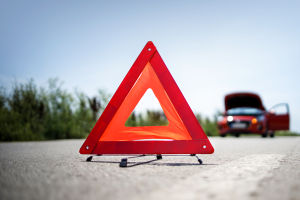
Hey Lykkers, stay safe on the road! Mechanical issues and roadside incidents can happen when least expected. In such moments, it's essential to remain calm and follow traffic regulations to keep yourself and others safe.
One of the most important safety tools in such situations is the emergency warning triangle. Knowing how to use it properly can prevent further hazards and help avoid penalties.
What Is the Emergency Triangle and Why Is It Important?
A Mandatory Safety Device
The emergency triangle is a key safety tool that alerts approaching drivers to a stopped vehicle ahead. It’s part of the standard safety kit required in every vehicle, along with a reflective safety vest or harness.
These tools help increase visibility and ensure other drivers can spot your vehicle from a safe distance.
Design and Visibility Requirements
This device must be foldable, sturdy, and constructed from durable materials. The outer surface should be made of retroreflective material, typically in bright shades such as red-orange, to enhance visibility. It must also include a stable support system that keeps it upright in various weather conditions—rain, snow, wind, or the air movement caused by passing vehicles.
When positioned correctly, it warns approaching drivers to reduce speed and prepare for a potential obstacle on the road. This can significantly reduce the risk of secondary incidents.
When Should the Emergency Triangle Be Used?
There are specific conditions where displaying the triangle is mandatory:
- On all roads outside populated areas
- At night, if rear lights or hazard lights are not working or are inadequate
- On non-urban roads when transported items fall or cause obstruction
- During the day, if the stopped vehicle or its load isn’t visible from a distance of at least 100 meters
While not required in urban areas, using it can still enhance safety in complex or high-traffic zones.
Steps to Follow Before Placing the Triangle
Before exiting the vehicle, switch on your hazard lights and put on your reflective vest or harness. This step is crucial, even if the vehicle is stopped in the emergency lane or a rest area. All passengers stepping out should wear the reflective gear too.
Once it's safe, place the triangle at an appropriate distance behind the vehicle to ensure it’s clearly visible to those approaching. If you're on a highway, it's especially important to be cautious due to fast-moving traffic.
Correct Placement of the Emergency Triangle
Follow these guidelines for proper placement:
- At least 50 meters behind the stopped vehicle or lost cargo, placed directly on the road surface
- Ensure it’s visible from at least 100 meters by oncoming drivers
- If there’s an intersection within 50 meters, adjust the position so it remains clearly visible
- Always place it on the same side of the road as the disabled vehicle, about 1 meter from the edge of the lane
- Make sure the reflective side is facing traffic and that the triangle stands firmly upright
Positioning the triangle correctly ensures drivers have enough time to react safely.
In Case of Trouble: Additional Safety Measures
Not carrying the emergency triangle or failing to use it when required can lead to financial penalties ranging from €42 to €123, along with a deduction of 2 points from your driving license.
The same applies to not wearing a reflective vest or harness in extra-urban areas when exiting the vehicle. Even if the triangle is unavailable, it remains essential to signal any obstruction on the road using other visible means to alert other drivers.
Once the emergency is resolved and the road is clear, remove the triangle promptly to avoid confusion or unnecessary slowing of traffic.
Getting Help on the Road
After securing the scene and placing the triangle, it's advisable to contact roadside assistance right away. Especially for those who frequently travel long distances, considering a travel-specific support plan can provide peace of mind and swift help in any unexpected situation.
Conclusion: Be Prepared, Stay Safe
Roadside problems can feel overwhelming, but with the right tools and actions, they become manageable. The emergency triangle is a small device with a big role—it alerts others, prevents further issues, and ensures compliance with road safety regulations.
So, Lykkers, before setting out on any journey, check that your vehicle is equipped with a compliant triangle and reflective gear. Being prepared means being safer—not just for you, but for everyone sharing the road.


